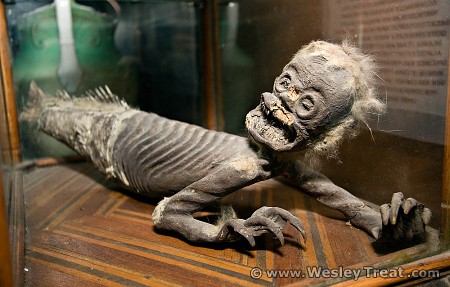It's probably the last thing you would expect to see in the high desert, but there it is. Fishlike in that it has the tail end of a fish, but manlike in that it has the forehead of Hume Cronyn, it's more like something you'd find on the cover of a tabloid.
You might call it a mermaid or, for the sake of equality, a merperson. The sign next to its glass case, however, refers to it specifically as a merman, clarifying the issue for us and saving everyone the trouble of checking under its fins.
His documentation — if that's what you want to call the inkjet printout on the wall — maintains that the desiccated oddity was caught in the Gulf of Tonquin somewhere off the coast of Vietnam. From what I could piece together from this and other sources, his saga then places him in the National Museum of China, from which he was reportedly purchased by Fook Woh & Co., a dealer of oriental imports in San Francisco. In 1880, the creature arrived in Tombstone, where he was displayed in Quong Kee's Can Can Restaurant for many years.
According to the printout, this merman and his kin once "caused great excitement among seamen" as they frequented the waters surrounding Eurasia. Though usually depicted as much more appealing, and often tragically seductive, merfolk have turned up in seafaring tales dating as far back as the 11th century BCE. Today, manatees are commonly credited for inspiring many mermaid sightings, but given the general attractiveness of a sea cow, it seems a bit unlikely. Perhaps hybrids like Tombstone's merman, or at least his good-looking cousins, were responsible.
Of course it could all just be one big fish story. P.T. Barnum, the great hoaxer himself, revealed a novelty very similar to this one in 1842, which he deemed the Feejee Mermaid. Barnum purported to have obtained it from a naturalist at the British Lyceum of Natural History who had discovered it in the South Pacific. In reality, the naturalist was a friend of Barnum's, there never was a British Lyceum of Natural History and the exhibit itself was a mummified patchwork of stitched animal parts. Since then, others like it have cropped up in unlikely spots, including one still on display at an alligator farm in Hot Springs, Arkansas, and another in a voodoo shop in New Orleans.
In 1934, the Can Can Merman moved into the Bird Cage Theatre when Quong Kee donated it to the establishment not long before his death. The bizarre creature has remained there ever since, tucked along a side wall, an obscure incongruity in a museum of Wild West memorabilia.
His day of fame may come once again, however, when another of his kind is fished from the ocean, proving his authenticity. After all, it's only a matter of time. As the sign says, his brethren are merely "almost extinct."





